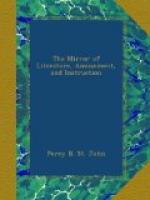Besides the places above mentioned, the palace-building Protector pulled down part of the Priory church of St. John, Clerkenwell, a chapel and cloisters near St. Paul’s cathedral, for the sake of the materials. He was, however, soon overtaken by justice, for in the proclamation, October 8, 1549, against the Duke of Somerset, previously to his arrest, he is charged with “enriching himselfe,” and building “sumptuous and faire houses,” during “all times of the wars in France and Scotland, leaving the king’s poore soldiers unpaid of their wages.” After the attainder and execution of the Protector, on Tower Hill, January 22, 1552-3, Somerset Place devolved to the Crown, and was conferred by the king upon his sister, the Princess Elizabeth, who resided here during her short visit to the court in the reign of Queen Mary. Elizabeth, after her succession to the throne, lent Somerset Place to Lord Hunsdon, (her chamberlain,) whose guest she occasionally became. He died here in 1596. On the death of Elizabeth, it appears to have become a jointure-house, or dotarial palace, of the queens’ consort; of whom Anne of Denmark, queen of James I. kept a splendid court here. Arthur Wilson, in his “History of King James,” generally calls this mansion “the queen’s palace in the Strand;” but it was more commonly called Denmark House; and Strype says that by the queen “this house was much repaired and beautified, and improved by new buildings and enlargements. She also brought hither water from Hyde Park in pipes.” Dr. Fuller remarks that this edifice was so tenacious of the name of the Duke of Somerset, “though he was not full five years possessor of it, that he would not change a duchy for a kingdom, when solemnly proclaimed by King James, Denmark House, from the king of Denmark lodging therein, and his sister, Queen Anne, repairing thereof.”
Pennant says, “Inigo Jones[2] built the back-front and water-gate about the year 1623;” but it may be questioned whether these were not the new buildings spoken of as having been previously raised by Anne of Denmark. Pennant likewise speaks of the chapel which was begun by Jones in the same year.
[2] Inigo Jones died at Somerset House, July 21, 1651.
Denmark House was next fitted up for Henrietta Maria, queen of Charles I., and settled on her for life. By her marriage articles, extraordinary concessions were made in favour of the Catholics. The queen was not only allowed to have, herself, the free exercise of the “Roman Catholic Apostolic religion,” but all her children were to be brought up in the same faith; she was to have a chapel in all the royal palaces; a bishop of her own faith was to be her almoner; twenty-eight priests, or ecclesiastics, were to serve in her chapel; the domestics of her household were to be French Catholics, &c. Thus, this mansion became the very focus of Catholicism, and a convent of Capuchin friars was established here by the queen. At length, in 1642, it was ordered by the Parliament that “the altar and chapel in Somerset House be forthwith burnt,” and that the Capuchins be “sent into France.”




